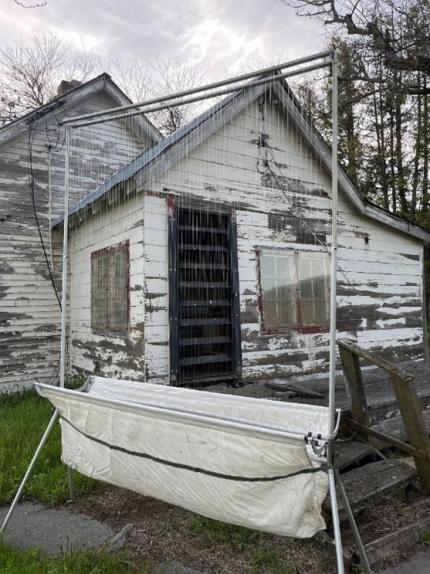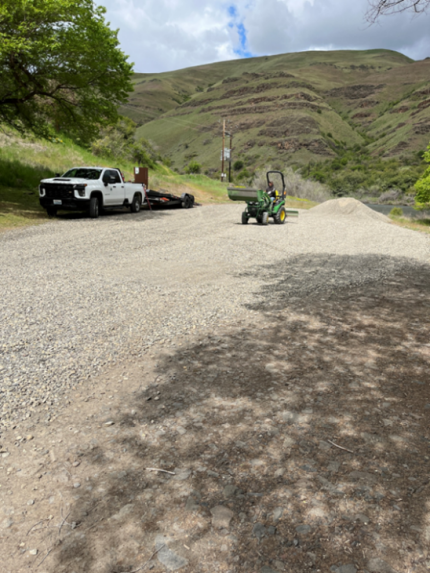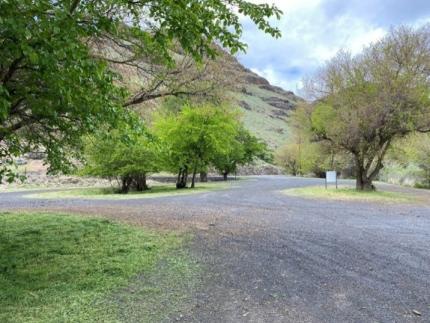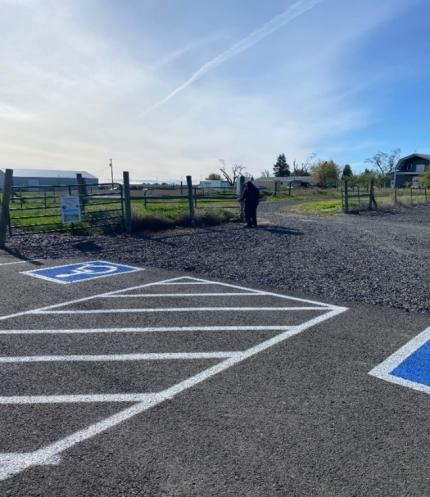Managing Wildlife Populations
Tucannon Bighorn Sheep: Wildlife Area Manager Dingman located the Tucannon bighorn sheep several times this week. Lambing should be happening anytime. There is only one ewe with a working collar currently. The ewes appear to be dispersing to get ready to lamb.
Golden Eagle Monitoring: Dingman checked the Cummings Creek, Merengo, and Hartsock nests this week. The Cummings Creek birds either did not nest or the nest has already failed this year. Both the Merengo and Hartsock nests have hatched, and each nest has at least one eaglet in it.
Five Sisters Wolf Pack: Biologists Lowe and Brinkman assisted Wolf Biologist Roussin with checking a trapline for wolves in the Five Sisters pack. One wolf, a 2-year old male, was captured and collared during this effort. The GPS collar attached to this wolf will help biologists identify core-use areas, and the approximate boundaries of this pack’s territory.
Sharp-tailed Translocated Grouse Update: So far, from the 30 Sharp-tailed Grouse that were translocated from British Columbia to the Swanson Lakes Wildlife Area office there have been two accounted mortalities. One of the mortalities was retrieved by the Region 1 assistant district biologist and frozen so that it could be transported to Washington State University for a full necropsy. The second mortality appeared to be a coyote predation.
Duck Banding: Wildlife Biologist Prince assisted Kalispel Tribe biologists with duck banding. The tribe is running a large-scale banding and radio-tagging project in collaboration with Washington Department of Fish and Wildlife.

Lincoln County Bats: Biologists Lowe and Brinkman captured bats at Rock Ranch in Lincoln County and obtained samples that will be tested for Pseudogymnoascus destructans (Pd), the fungus that causes white-nose syndrome in bats. White-nose syndrome has not been detected in bats in Lincoln County; however, surveillance efforts are critical to early detection of Pd. Other Washington Department of Fish and Wildlife staff members, Bureau of Land Management employees, and a professor and students from Eastern Washington University assisted with the capture effort.


Providing Recreation Opportunities
Boggan’s Access Site Improvements: Access Manager Heimgartner ordered six truckloads of gravel for the Boggan’s Access Site using recent new supplemental budget funds. Natural Resource Technician Nielsen later used the access area tractor to complete the gravel spreading project. They anticipate there may be a few more gravel deliveries made with the goal of covering the entire site with a new surface.


Access Areas Spring Opening: North Region 1 Water Access Area Manager Dziekan and his assistant, Natural Resource Technician Brant, had the summer seasonal access areas ready for this week’s opener. Dziekan noted that he typically sees heavy site use with the spring opener, but based on the condition of the toilets, that appeared not to be the case this week. This will probably change once the weather starts getting a bit nicer. Over the week, Dziekan and Brant conducted routine activities such as cleaning restrooms, picking up litter, and applying herbicide to weedy areas.
Turkey Access: Private Lands Biologist Nizer answered phone calls and emails regarding turkey access and gave advice to turkey hunters wanting to hunt in Whitman and Spokane counties. Nizer spoke to a hunter and directed him to a property enrolled in the Hunt by Written Permission Program. The hunter came from Alabama to hunt turkeys and was successful on the property.

Recreation Access Site Maintenance: Heimgartner and Nielsen worked together to clean access sites across the district from Heller Bar and the Grand Ronde River to the Wooten Wildlife Area campgrounds. They picked up trash, sprayed weeds, and restocked supplies. They also cleaned the shooting ranges. Wade cut vegetation around the Asotin Creek shop and gate.

Reardan Audubon - Access Manager Dziekan and Natural Resource Technician Brant spent some more time out at Reardan Audubon lakes this week. There was an application of herbicide a couple weeks ago, targeting broadleaf and grass. This time around, the broadleaf control was very effective, the grass control was effective, but more grass started popping up since the last visit.
Brant focused on string trimming the entrance gate on the southern parking area, cutting down tall grass and dead weeds that had either previously been sprayed or blown in and gotten trapped on the fence. The string trimming work was done after the grass was mowed along the driveway leading to the property.
While Brant was working on beautification, Dziekan loaded up some glyphosate and worked on getting the areas of new growth. More work is planned for this site, but they wanted to eliminate the grass growing in the rip-rap rock along the trail. The northern parking area is looking great. Dziekan applied broadleaf herbicide last season along the trail and had good results.


Providing Conflict Prevention and Education
Trail Camera Check. Wildlife Conflict Specialist Bennett worked with a livestock producer with concerns of a recent calf loss. A coyote was the only wildlife noted on the trail camera in Pend Oreille County.

Cougar Activity: Washington State Department of Fish and Wildlife staff members trapped a juvenile male cougar in Columbia County. The cougar was in poor body condition and exhibiting behavior consistent with habituation. The cougar was transported to Department carnivore specialists for potential placement in a zoo or sanctuary.
Beaver Evaluation: Wildlife Conflict Specialist Kolb met with a beaver relocation specialist and conducted a site visit in Walla Walla County. Current beaver activity has damaged critical shade trees utilized by cattle in the summer and blocked the flow of water to an irrigation pump. Washington Department of Fish and Wildlife habitat biologists also assisted in providing near-term relief for the producer. Additionally, the beaver relocation specialist will meet with their team about long-term solutions for the problem area (for example a pond leveler/beaver deceiver).
Bear Concerns in Stevens and Pend Oreille Counties. Wildlife Conflict Specialist Bennett worked with eight landowners with bear damage questions and concerns. Information on deterrents and securing attractants were covered. Bennett also reached out to the local garbage disposal company on a long-term solution.
Conserving Natural Landscapes
Spring Habitat Work: Private Lands Biologist Nizer met with Private Lands Biologist Baarstad and Natural Resource Technician Keeling. Nizer assisted with planting 500 trees at a hunting access site. Nizer planned a last-minute spring planting at a Hunt by Written Permission property for clover and alfalfa. Nizer met with another landowner to discuss guzzler implementation for this summer.
Riparian Shrub Project: Wildlife Area Manager Finch and Private Lands Biologist Baarstad prepared a rototiller and attached it to the tractor and moved it to the project site south of Z-Lake. The site was sprayed out with Roundup so that it could be tilled before laying matting material. Region 2 Private Lands Biologist Braaten came to help lay the matting material. Plants were delivered from Plants of the Wildlife the following day. The Aquatic Lands Enhancement Account (ALEA) riparian shrub planting day with volunteers was on May 11. The Spokane Chapter of the Pheasant Forever Habitat Chairman Gruenke and the Spokane Audubon will be working together to complete this important winter habitat project.
The Pheasant Forever chapter listed this project on their national website. OnX is offering a chance to win a $7,500 grant for habitat projects so Pheasant Forever will be taking a lot of pictures. Pheasant Forever even mentioned this cooperative project may get published in the Pheasant Forever Magazine. It would be a great example of a cooperative project between Washington Department of Fish and Wildlife, Audubon, and Pheasant Forever.
Carcass Pit Retirement: The state Department of Transportation (DOT) has finished using its highway carcass drop pit off Trout Lake Road at Scatter Creek Wildlife Area, opting to take local roadkill to other disposal sites off Washington Department of Fish and Wildlife lands. DOT has covered the trenches, and Sherman Creek Wildlife Area staff members would like to implement a full site rehabilitation of the pit area, which had several trenches used over the decades. One option is to submit a grant to the state Recreation and Conservation Office (RCO) for the cost of planning and implementing the site work. Thanks go to Region 1 Manager Kuttel for working with DOT to get the pit closure implemented so quickly!
Smoothing Iron Ridge Field Work: Natural Resource Specialist Whittaker finished up spring planting of 50 acres of oats, ten acres of spring wheat, and 3.5 acres of a sunflower/millet/sorghum mix. He then cleaned up the equipment and put it in storage until fall planting time. A part broke on the drill and Whittaker and Wade worked together to reinstall a new part.
Whittaker reported seeing a cow and calf moose running across the hillside on the Asotin Creek Wildlife Area.



Riparian Shrub Project: This week all the planning and work for the Aquatic Lands Enhancement Account (ALEA) riparian shrub planting project at Swanson Lakes Wildlife Area is underway. Saturday is the big work party. They are expecting approximately 35 volunteers who will help plant 780 shrubs and trees and construct a 7.5’ deer fence around the planting. Prior to the workday the site was prepped by rototilling and laying the matting material.


Providing Education and Outreach
Turkey Presentation: Wildlife Conflict Specialist Harris and Officer Beauchene met with a group of first-time turkey hunters at Porcupine Bay Campground to discuss wild turkey biology and management in Washington. The turkey camp was put together by the Armed Forces Initiative and Backcountry Hunters and Anglers.
Medical Lake Middle School STEM Career Night: Biologist Brinkman attended a career night with other Washington Department of Fish and Wildlife (WDFW) representatives at Medical Lake Middle School. Students and parents visited the tables of WDFW and other local organizations that have professionals working in a field related to the STEM curriculum. WDFW provided outreach materials covering various programs (for example, fish, wildlife, habitat, and enforcement) in our agency.

Conducting Business Operations and Policy
General Facilities and Equipment Maintenance and Repairs: Wildlife Area Assistant Manager Palmer repaired part of the field irrigation system coming from Sherman Creek, by the diversion box adjacent to the Inchelium Highway. A section of the pipe was apparently damaged by a vehicle leaving the roadway since the last irrigation season. Palmer cold-welded a hole in the corrugated metal pipe and resealed coupler joints, fixing the leak.

